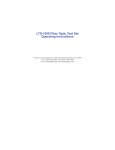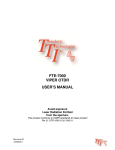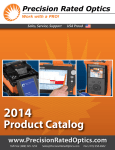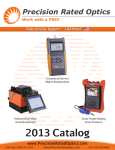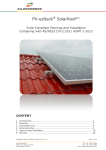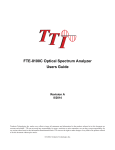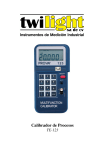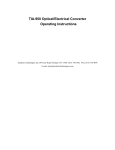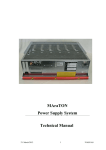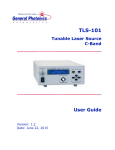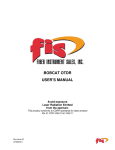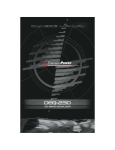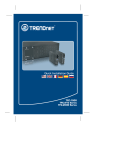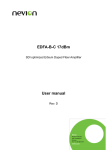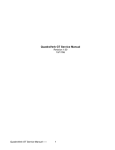Download FTE-6000 Manual - Terahertz Technologies Inc.
Transcript
FTE-6000 Hand Held Tuneable Laser Source USER’S MANUAL Avoid Exposure Laser Radiation Emitted From The Aperture This product conforms to CDRH standards for laser product Per 21 CFR 1040.10 & 1040.11 Revision B 4/2013 Revision B 4/2013 Table of Contents SECTION PAGE 1.0 Safety………..…………………...……………..……….……………….......……………………………1 1.1 1.2 1.3 1.4 General Safety Laser Safety Fiber Optic Connection Power Supply 2.0 FTE-6000 Quick Start……………………..………….…………...........................……………………2 3.0 Introduction ……………………………………..………………………………………….……………..3 4.0 Preparation for Use ………………………………………………………………………………...……4 4.1 4.2 4.3 Inspection Instrument Identification / Configuration Power Requirements 5.0 Description……………......……….………………………………….…………...………..……………..5 5.1 5.2 5.3 5.4 Mechanical Instrument Enclosure Physical Front Panel Top Plate Bottom Plate Display Icon Definitions 6.0 Feature/Preference Description and Settings ………….………………..……...……….……..……...8 6.1 6.1 Feature Description and Operations Battery Level/Power Indicator Help USB Flash Drive USB/PC Operating Temperature User Preferences Brightness Setting Speaker I Revision B 4/2013 7.0 Operation…………………………..………………………………...……….……………..…………..…9 7.1 7.2 7.3 7.4 7.5 7.6 7.7 Key Pad Power On Display Units Setting 1st Channel Setting Sweep Parameters Step Size Power Level (dBm) Dwell Time Sweep Span Continuous / Single Sweep Start Sweep Laser Activity Indicator Pause Sweep Manual Selection of Channel Single Channel Operation Manual Adjust Method Lambda Button Method 8.0 Maintenance ……………………………………………………………………..…….…………………… 14 8.1 8.2 8.3 Battery Replacement Recalibration and Verification Adapter Replacement 9.0 Specifications …………………….………….……………………..……….……….……………………..15 10.0 Warranty and Repair………………………………….…………………….….....….…………………...16 Warranty Information Repair Information 11.0 Trouble Shooting………………………………...………….……………..………………….……..……17 12.0 Version Control………….….…………….………………………….....………………………..………..18 II Revision B 4/2013 1.0 Safety CAUTION: Please Read This Prior To Operation 1.1 General Safety This product has been designed and tested in accordance with the Manufacturer’s safety standards and has been supplied in a safe condition. This document contains information and warnings that must be followed by the user to ensure safe operation and to maintain the product in a safe condition. 1.2 Laser Safety The Tuneable Laser Source has been configured to provide laser radiation in the C or L bands. This may be wavelengths from ~1520nm to ~1608nm. Please see the warning label in figure 1.1. This is displayed on the top panel of the Tunable Laser Source, just above the optical port. The unit has been designed to comply with 21 CFR (Code of Federal Regulations) 1040.10 and 1040.11, for Class 1M emission limits. Although Class 1 levels Fig 1.1 are not considered to be hazardous, we suggest limiting exposure by never looking directly into the optical aperture. Also, do not under any circumstance view or inspect the laser output fibers, connectors or the fiber under test through collimating or focusing optics unless the unit is turned off, batteries are removed and the power adapter is disconnected. WARNING: Never clean or look directly into the fiber optic connector or the end of fiber attached to the Tunable Laser Source while it is energized, to do so will expose the user to laser radiation and could result in personal injury or instrument damage. Never activate the laser without attaching a fiber to the fiber output port. WARNING: Before connecting a fiber to the TLS, be certain the fiber has no other active optical sources or sensitive instruments connected to the other end. Feeding power back into the TLS could result in damage or the TLS could damage equipment not designed to receive its signal. This action could result in voiding the warranty. 1.3 Fiber Optic Connection Fiber-optic connectors are easily contaminated or damaged. The connection to the FTE-6000 is a physical contact type of connection and dirty or damaged connectors will impair the instrument’s capabilities at the minimum and at worst result in the need to return the equipment to the factory for expensive repairs. Caution: Prior to making any connection to the unit ensure that all proper cleaning procedures have been followed. 1.4 Power Supply To Prevent Fire or Shock Hazard: Do not install battery types other than those supplied by the manufacturer; Do not use the charger without the batteries installed. Do not expose the battery charger to rain or excessive moisture. Do not use the AC adapter when there are signs of damage to the enclosure or cord. Do not use any other charger than the one provided with this instrument. Any other condition will void the warranty. 1 Revision B 4/2013 2.0 FTE-6000 Quick Start Guide to energize the FTE-6000. Press Note: The FTE6000 has a short warm-up period which is noted by the “Please wait, Laser is Initializing” statement on the display. At power up, the Step Size soft key will be highlighted. Press and use the scroll wheel to select the desired step size of the sweep. 0.4nm (0.05THz), 0.8nm (0.10THz) or 1.6nm (0.20THz). Press again to exit step size adjustment. Note: If the dwell time is set for anything other than Manual Adjust, may also be used to toggle the step size adjustment. While in Manual Adjust mode, the button may only be used to step through the sweep one channel at a time. Press to highlight the power level setting. Use the scroll wheel to set the power level from +3.00 dBm to +9.00 dBm in 0.01 dBm increments. Press again to exit power level adjustments. Press the button to highlight the dwell time setting. Use the scroll wheel to adjust the dwell time from 0.00 seconds (Manual Adjust) to 600 seconds. Press again to exit dwell time adjustment. Scroll to highlight the (Start Channel) icon and press the set the first channel to be activated. Press Scroll to the again to exit. (End Channel) icon and press be activated. Press the button. Use the scroll wheel to . Use the scroll wheel to set the last channel to button again to exit. Note: If the start channel setting is lower than the end channel, the sweep will progress upward and if the start channel is higher than the end channel the sweep will progress downward. Press the button to start and stop a sweep. 2 Revision B 4/2013 3.0 Introduction The TTI FTE-6000 Series Hand Held Tuneable Laser Source is offered in two versions, “C” Band (1529– 1563nm) and “L”-band (1569 -1607nm). It has adjustable output power with a resolution of 0.01 dB. Power levels range from +3 dBm to +9 dBm. Step size, power level and dwell time are adjustable settings to optimize sweep parameters. Single or continuous sweeps may be programmed. Selection of the first and last channels to be activated may also be programmed. The channels may be displayed in either wavelength or frequency and the wavelength/frequency associated with the first channel is user settable. The unit has a 4 inch color TFT Display and the FTE-6000 may be operated as a virtual instrument using the TTI CertSoft Windows™ compatible certification software suite. The FTE-6000 is housed in a rugged metal enclosure with a robust protective boot. These units are designed for field use and are extremely user friendly. 3 Revision B 4/2013 4.0 Preparation for Use 4.1 Inspection Before shipment, this instrument has been inspected and found to be in perfect working order and free of defects. The shipping carton contains the following: 1. 2. 3. 4. 5. Hand Held Tuneable Laser Source, with protective boot and 8-AA NiMH batteries installed Universal AC/DC charger with interchangeable mains plugs USB cable Manual and software on CD Set of interchangeable adapters, SC and FC. (Shipped with FC adapter installed) 4.2 Instrument Identification/ Configuration The instrument’s Model, Part Number, Serial Number and Date of Manufacture are indicated on a label located on the bottom plate of the unit. The instrument’s history is filed at the factory by part number and serial number. 4.3 Power Requirements Fig 4.1 The FTE-6000 is equipped with a 100-240V-0.4A input universal battery charger with 13.6V, 0.75A, (center positive output). The charger is supplied with interchangeable mains plugs for North America, Great Britain, Europe and Australia. The unit’s internal power pack is comprised of eight AA NiMH cells with a capacity of 2700mA hours. Depending on usage, a fully charged battery pack will provide approximately 4 hrs of operation. Typically, fully discharged batteries require 6 - 8 hours of recharging. Battery replacement is not recommended. However if you must replace the batteries follow the following procedure. Unplug the external power supply and carefully remove unit from its protective boot. Remove two screws each from the top and bottom plates. These retain the back cover. Carefully remove the back cover and remove the two screws that hold the two battery covers in place. Replace only with high quality AA NiMH batteries. If you install NiMH batteries that are discharged, charge these batteries for at least one hour before using the FTE-6000. For maintenance, batteries require a monthly periodic recharge. WARNING: To Prevent Fire or Shock Hazard: Do not install other battery types. Do not use the charger without the batteries installed. Do not expose the battery charger to rain or excessive moisture. Do not use the AC adapter when there are signs of damage to the enclosure or cord. Do not use any charger other than the one provided with this instrument. Any other condition will void the warranty. 4 Revision B 4/2013 5.0 Description 5.1 Mechanical Instrument Enclosure The TLS is packaged in a rugged aluminum housing which is further protected with a rubberized boot. Although the front panel is weather resistant, reasonable care should be taken to avoid liquids and contaminants around the fragile optical and electrical connectors, and the LCD display. Use a mild cleaning agent and damp soft cloth to clean the panels and the outside case. Refer to the maintenance section to clean the optical connector. NEVER open the instrument for cleaning. Return to the factory for servicing if necessary. 5.2 Physical Front Panel Charge Indicator Display Key Pad Scroll Wheel Fig 5.1 5 Revision B 4/2013 Top Plate Optical Signal Output Bottom Plate USB Flash Power Jack USB PC Fig 5.2 5.3 Display Soft Keys Sweep Parameters Icon Bar Active Wavelength/Frequency Laser Status Battery Indicator Channel Information Fig 5.3 6 Revision B 4/2013 5.4 Icon Definitions Help Feature Invokes the Tunable Laser Source onboard help feature Lambda The lambda icon is used to switch between displaying channels in wavelength (nm) or frequency (THz) Sweep Start This setting allows the user to set the first channel of a sweep Sweep End This setting allows the user to set the last channel of a sweep Continuous Sweep This icon is displayed when the TLS is set to repeat the sweep Single Sweep This icon is displayed when the TLS is set to run a sweep only once Brightness Toggles backlight to bright or dim illumination Speaker Toggles the speaker on and off Baud Rate Sets the com port baud rate for communication with a computer First Channel This matches the wavelength/frequency of the first channel of this instrument with the first channel of other equipment being used. Calibration Calibration is for factory use only 7 Revision B 4/2013 6.0 Feature / Preference Description and Settings 6.1 Feature Description and Operation The scroll wheel is used to select soft keys and/or icons unless a sweep parameter is highlighted. Battery Level/Power Indicator The bottom right hand corner of the screen shows the battery level and charge indicator. In the final hour of operation the battery will change to red. A warning indicator will sound a few minutes before the instrument automatically turns off. Ensure that the unit is turned off when plugging in the Battery Charger. Help The Tunable Laser Source has an onboard help feature. To access this help feature, use the scroll wheel to highlight the help icon and press Select to display the help menu. Scroll to the desired topic and press Select. Use the scroll wheel to move down the help page. To exit the help feature, scroll to exit at the bottom of the topic list and press Select. USB Flash Drive USB Flash drive is non-operational and included for future enhancements. USB/PC Located on the bottom panel is the USB/PC port which may be used to connect the TLS to a computer in order to operate in virtual mode with the CertSoft Windows™ compatible software suite. Operating Temperature The FTE-6000 is designed to operate at ambient temperatures from -10 to 40 C. If the unit is exposed to conditions that cause it to exceed its operating temperature, the optic module will stop emitting. The TLS should be powered down and attempt to moderate temperature conditions. 6.2 User Preference Settings Brightness Setting Scroll to the Backlight icon. Press the Select button to toggle the back light to either bright or dim. Speaker Scroll to the Speaker icon. Press the Select button to toggle the speaker on and off. 8 Revision B 4/2013 7.0 FTE-6000 Operation 7.1 Key Pad Power button, turns the unit On and Off. (Hold for 1 second) Sweep button, pressing this button will start or stop the laser. Fig 7.1 The Lambda or wavelength button is used to set the channel or move a specific start point within a sweep. The dBm or Power Level button is use to set the output power level. The Step button is used to set the step size of a sweep or while in Manual Adjust mode, step through the set channels. The Dwell button is used to set the dwell time in seconds of each step in a sweep. The Select button is use to select highlighted soft keys and icons. 9 Revision B 4/2013 7.2 Power On WARNING: Fiber-optic connectors are easily contaminated or damaged. The connection to the FTE-6000 is a physical contact type of connection and dirty or damaged connectors may impair the instrument’s capabilities at the minimum and at worst result in the need to return the FTE-6000 to the factory for repairs. Prior to making any connection to the unit, ensure that all proper cleaning procedures have been followed. Press the power button for one second to energize the FTE6000. 7.3 Display Units The output channel may be displayed in wavelength or frequency. To set the units, use the scroll wheel to highlight the Lambda (λ) Icon, press Select to toggle between wavelength (nm) and frequency (THz). This also changes the units display for step size, sweep begin and sweep end. 7.4 Setting the 1st Channel The wavelength/frequency of the first channel on the FTE-6000 may be set to match the first channels of other test equipment. Use the scroll wheel to highlight the 1st channel icon and press Select. Set the wavelength/frequency to be shown as channel number one. Press the Select button, use the scroll wheel to select desire action and press Select again. 7.5 Setting Sweep Parameters Step Size There are three available step sizes, 0.4nm (0.05THz), 0.8nm (0.10THz) and 1.6nm (0.20THz). To set the step size, press the Step button (unless the Dwell time is set to Manual Adjust, then the scroll wheel must be used to highlight Step Size) and use the scroll wheel to make your selection. Press the Step button a second time to exit. The step size may also be adjusted by means of the Step Size soft key. Use the scroll wheel to highlight the Step Size soft key, press select and use the scroll wheel to set the desired step size. Press Select a second time to exit. Note: When the dwell time is set to Manual Adjust, the soft key method is the only method available for setting step size. When the dwell time is set to Manual Adjust, the Step button increases the channel up or down the scale, depending on the start and end channel settings. 10 Revision B 4/2013 Power Level (dBm) The power level of the signal is adjustable from +8 dBm to +14 dBm (C Band) and +5 dBm to +11 dBm (L Band) in increments of 0.01 dBm. To set the power level, press the dBm button, use the scroll wheel to adjust the power and press the select button a second time to exit. This may also be accomplished by using the Power Level soft key. Use the scroll wheel to highlight the Power Level Soft Key, press select, use the scroll wheel to set the power and press Select a second time to exit. Dwell Time The duration of each step may be adjusted with the Dwell button. The dwell time ranges from Manual Adjust to 600 seconds. In Manual Adjust mode, the sweep function is disabled and the wavelength is only manipulated with the Step button, one channel at a time. To set the dwell time, press the Dwell button, use the scroll wheel to set the time and press the Dwell button a second time to exit. This may also be accomplished by using the Dwell Time soft key. Use the scroll wheel to highlight the Dwell Time Soft Key, press select, use the scroll wheel to set the power level and press Select a second time to exit. Sweep Span The span of a sweep may be limited with the Sweep Begin and Sweep End icons. The sweep start channel is indicated in the lower left corner of the display in green and the sweep end channel is indicated in the lower right corner of the display in red. To set the start and end channels use the scroll wheel to highlight the span start or end icon, press the Select button to highlight the appropriate indicator, use the scroll wheel to adjust the setting and press the Select button again to exit. Note: If the start channel setting is lower than the end channel, the sweep will progress upward and if the start channel is higher than the end channel the sweep will progress downward. Continuous / Single Sweep A sweep may be set to run continuously or to run though one time and stop. This is indicated in the icon bar by the continuous or single sweep icons. To change this setting, use the scroll wheel to highlight the indicated icon and press Select to switch to the opposite setting. 7.6 Start Sweep Once the desire parameters have been established the Sweep button may be pressed to start and stop a sweep. The progression of the sweep is indicated in the lower middle of the display with a progress bar. 11 Revision B 4/2013 Laser Activity Indicator Laser activity is indicated by the blinking laser symbol just below the active wavelength/frequency in the center of the display. When the laser is off, the red octagon with “OFF” is displayed in the place of the Laser symbol. WARNING: Even if the indicator shows the laser to be off never looking into the end of a fiber connected to the TLS or directly into the connector port. Do not under any circumstance view or inspect the laser output fibers, connectors or the fiber under test through collimating or focusing optics unless the unit is turned off, batteries are removed and the power adapter is disconnected. WARNING: Never clean or look directly into the fiber optic connector or the end of fiber attached to the Tunable Laser Source while it is energized, to do so will expose the user to laser radiation and could result in personal injury or instrument damage. WARNING: Before connecting to a patch cord or fiber under test, be certain the fiber has no active optical sources or instruments connected to the other end. Skin or eye damage could result from other high power sources e.g. EDFAs, or instrument damage could occur voiding the warranty. Note: The wavelength/frequency displayed in the center of the display is an absolute value. The Channel number associated with the wavelength is a user settable value by using the 1st Channel Selection icon. This setting is stored in nonvolatile memory. Pause a Sweep Press the Lambda button to pause a sweep. The wavelength/frequency will be highlight and the scroll wheel may be used to change the active channel. Press the Lambda button again to continue the sweep from the point selected with the scroll wheel. Manual Selection of a Channel To manually select a channel, with scan active or off, press the Lambda button to highlight the wavelength/frequency in the center of the display. Use the scroll wheel to select the desired wavelength/frequency. Press the Lambda button again and if the unit was paused, the scan will continue from the point selected. If the unit was not scanning, pressing the scan button will start the scan from the point selected with the scroll wheel. 12 Revision B 4/2013 7.7 Single Channel Operation There are two methods to operate at a single channel. Manual Adjust Set the Dwell to Manual Adjust. Press the Lambda button to highlight the wavelength/frequency. Use the scroll wheel to select a channel and press the Lambda button to exit. Press the Laser button to fire the laser. Lambda Button Press the Lambda button to highlight the wavelength/frequency. Use the scroll wheel to move through the channels within the parameters of the start and end sweep settings. Leave the wavelength/frequency highlighted and press the laser button. The selected channel will be emitted. Use the scroll wheel to cycle through the channels or select another channel while the laser is firing. The sweep function is halted when wavelength/frequency is highlighted. 13 Revision B 4/2013 8.0 Maintenance 8.1 Battery Replacement Battery replacement is not recommended, however, if you must replace the batteries follow the following procedure. Unplug the external power supply and carefully remove unit from its protective boot. Remove two screws each from the top and bottom plates. These retain the back cover. Carefully remove back cover and remove the two screws that hold the two battery covers in place. Replace only with high quality AA NiMH batteries. If you install NiMH batteries that are discharged, charge these batteries for at least one hour before using the FTE-6000. For maintenance, batteries require a monthly periodic recharge. WARNING: To Prevent Fire or Shock Hazard: Do not install other battery types. Do not use the charger without the batteries installed. Do not expose the battery charger to rain or excessive moisture. Do not use the AC adapter when there are signs of damage to the enclosure or cord. Do not use any charger other than the one provided with this instrument. Any other condition will void the warranty. For maintenance, the batteries require a monthly periodic recharge. 8.2 Recalibration and Verification Periodic verification of the TLS is recommended to ensure that your instrument remains within specification. Although not imperative, we recommend a verification and optical connector check once a year to make certain the instrument is functioning properly and performing to its rated specifications. Consult the factory for service. 8.3 Adapter Replacement The FTE-6000 is supplied with two easily interchangeable adapters per port, SC/FC. To change an adapter, remove the two screws that hold the adapter in place, pull the adapter straight up from ferrule. It is suggested that you clean the exposed ferrule with an appropriate cleaner and lint free wipes anytime you replace the ferrule. Note: In order to maintain a low loss fiber connection, care should be taken to adequately clean the ferrule of any connector to be connected to the FTE-6000. In the event that the port needs to be cleaned, the first step is to be certain the instrument is off. We suggest the use of isopropyl alcohol and foam swabs specifically designed for cleaning connectors accepting 2.5 mm ferrules. NOTE: When replacing the adapter with one that does not have a chained protective cap, use the small screw in place of the larger screw that retains the end of the chain to the adapter base. 14 Revision B 4/2013 9.0 Specifications Wavelength Range FTE-6000-C 192 THz – 196 THz (1529-1563nm) FTE-6000-L 187 THz – 191 THz (1569-1607nm) Accuracy 1.5 GHz Line Width 1 MHz Side Mode Suppression Ratio 45 dB Typical Output Power Range +8 dBm to +14 dBm (C Band) +5 dBm to +11 dBm (L Band) Power Setting Resolution 0.01dB Power Variation over Wavelength Range +0.0 to -0.5 dB Minimum Channel Spacing 50 GHz (0.4nm) Fiber Type 9/125um Relative Intensity Noise -140 dB/Hz Optical Interface Universal UPC (FC/SC) Display 4 in Color TFT Dimensions 7.75 x 4.5 x 2.25 inches Weight 2 lbs Battery Rechargeable NiMH - 4 hours operating time Power 100-240 Universal Adapter with US, GB, EU, AU Environmental Accessories Included Operation -10°C to + 40°C Universal Power Supply, Interchangeable FC and SC Adaptors, Window’s Compatible Software, USB Cable, Manual on CD and Rubber Boot TM Specifications are subject to change without notice 15 Revision B 4/2013 10.0 Warranty and Repair 10.1 Warranty Information Limited Warranty TERAHERTZ TECHNOLOGIES INC. (“TTI”) WARRANTS THAT TO THE FIRST PURCHASER, FOR A PERIOD OF TWELVE MONTHS FROM THE DATE OF RECEIPT, THAT THIS PRODUCT (“THE PRODUCT”) WILL BE FREE FROM DEFECTS IN MATERIALS AND MANUFACTURING. THE FOREGOING WARRANTY IS THE ONLY WARRANTY, EXPRESS OR IMPLIED, GIVEN BY TTI, I.E., THERE IS NO WARRANTY OF FITNESS FOR A PARTICULAR PURPOSE. TTI HEREBY DISCLAIMS ANY EXPRESS OR IMPLIED WARRANTY OTHER THAN THE WARRANTY IN THE FIRST SENTENCE TO THE FULLEST EXTENT PERMITTED BY LAW. THE SOLE AND EXCLUSIVE REMEDY UNDER THIS WARRANTY IS REPAIR OR REPLACEMENT AT TTI’S OPTION OF ANY PRODUCT THAT PROVES TO BE DEFECTIVE IN MATERIALS OR MANUFACTURING WITHIN TWELVE MONTHS OF RECEIPT OF THE PRODUCT. NOTE: THIS WARRANTY DOES NOT APPLY TO ANY PRODUCT WHICH HAS BEEN SUBJECT TO MISHANDLING, MISUSE, OR SERVICE BY UNAUTHORIZED PERSONNEL OR TO ANY PRODUCT WHICH HAS BEEN DAMAGED, MODIFIED, ALTERED OR TAMPERED WITH, AND DOES NOT APPLY TO EXPENDABLE COMPONENTS SUCH AS BATTERIES OR OPTICAL CONNECTORS. TO THE FULLEST EXTENT OF THE LAW, TTI DISCLAIMS ALL LIABILITY FOR ANY OTHER DIRECT, INCIDENTAL OR CONSEQUENTIAL DAMAGES ALLEGED TO BE CAUSED BY A DEFECTIVE PRODUCT, I.E., TTI WILL NOT BE RESPONSIBLE FOR ANY PERSONAL INJURY, PROPERTY DAMAGE OTHER THAN THE COST OF REPLACING THE PRODUCT OR ANY OTHER MONETARY DAMAGE SUCH AS LOST WAGES OR PROFITS CAUSED BY ANY USE, ATTEMPTED USE OR INABILITY TO USE THE PRODUCT. NOTE: BY USING THE PRODUCT, YOU AGREE THAT REPAIR OR REPLACEMENT AT TTI’S OPTION WILL FULLY SATISFY TTI’S WARRANTY OBLIGATION TO YOU, WHETHER IN CONTRACT, TORT, NEGLIGENCE, STRICT LIABILITY OR OTHER APPLICABLE LAW. This warranty does not apply to expendable parts such as batteries, nor to any instrument or component which has been subjected to misuse, alteration, or fiber connector damage. It is the customer’s responsibility to understand all the instructions and specifications prior to operating this instrument. This warranty does not extend to any loss or damage consequent to the failure of the warranted product. 10.2 Repair Information If repair is required, contact Terahertz Technologies Inc. at +1 315-736-3642 or [email protected] for return instructions and a RMA number. 16 Revision B 4/2013 11.0 Trouble Shooting Symptom LCD dark LCD white Instrument locked Up Low or no power being displayed USB connection to PC not functioning properly Possible Cause Power not on Solution Press ON/OFF key Batteries require recharging Recharge batteries Batteries are missing, in backwards or need replacement Check polarity, replace batteries, or contact factory for servicing Power cycled too quickly Turn off wait 5 seconds – turn on Defective cord or dirty connector Turn off (hold ON/OFF button in for 1 second) wait 5 seconds – then depress On/Off again button to turn the unit on. Replace or clean cord Fiber Output port requires cleaning Clean and inspect port Angle polish mated with UPC polish Examine connector ends Set port baud rate properly or decrease Baud rate in instrument and certification software Unexpected Operational Mode USB baud rate not set properly or too quick for computer Uninstall & reinstall certification software and drivers PC drivers not set properly 17 Revision B 4/2013 12.0 Version Control Through a program of continuous improvement, we upgrade the features and performance of the instrument in an on going process. The instrument firmware version is accessible at “turn-on” on the bottom right-hand corner of the display. The version changes and approximate release dates are as follows. V1.0 – 9/2011 – Original release - Requires version 1.0 software V1.1 – 2/2012 – Added support for L band Lasers - Requires version 1.0 software V1.2 – 4/2012 – Affords user versatility when setting the first channel - Requires version 1.0 software V1.3 – 4/2012 – Allows unit to display ITU grid channels in frequency - Requires version 1.0 software ©TTI 2011 18 Revision B 4/2013






















